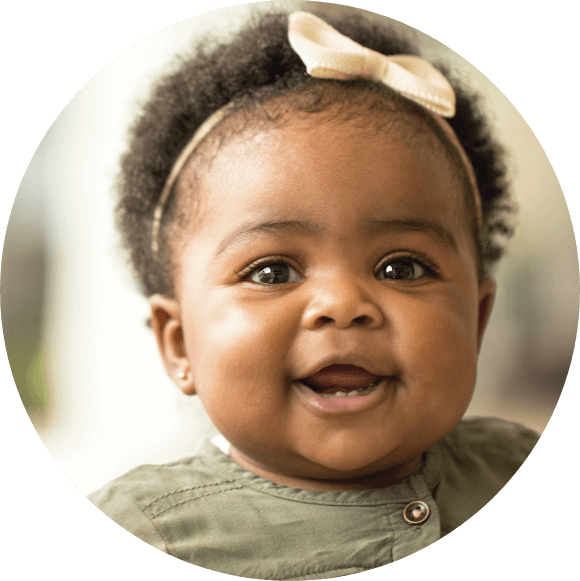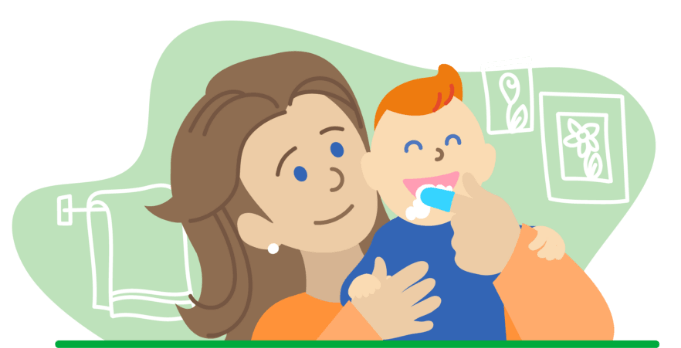
That gummy grin melts your heart. Soon, baby teeth will poke through and your little one may become irritable, fussy, drool more than usual, lose their appetite, or have trouble sleeping. Here’s what to expect during the first stage of your baby’s oral development.
When your baby has a gummy smile, oral care might not be top of mind. But it’s important to get in the habit of cleaning your baby’s teeth and gums every day. Keep browsing for helpful advice during this early development stage.

Gum care for babies doesn’t include a toothbrush or toothpaste. And it’s as easy as 1-2-3!
After feedings and at bedtime, be sure to wipe your baby’s mouth. Use a clean, damp washcloth or gauze pad.
Place the damp washcloth or gauze pad on your finger. Then gently wipe it over your baby’s gums as well as the top and bottom of their mouth.
This simple wipe down helps remove icky bacteria. It’s easy and is a great start to healthy oral care.
It’s a big day when that first tooth appears. Time to add finger brushing to the routine. Don’t worry, we’ll help!
Use a soft finger brush designed for little mouths and a pea-size amount of tooth and gum cleanser to gently help remove food and plaque while brushing even the tiniest teeth. Baby Orajel™ Elmo Tooth & Gum Cleanser with Finger Brush makes easy work of this new task!
Brush baby’s gums and tongue in a gentle circular motion.
To maintain a routine, brush at the same time every day.
For the average baby, teeth break through around 6 months. But it can start as early as 3 months and as late as 12 months. Most children have all 20 of their primary teeth by their 3rd birthday.
Contact your doctor or healthcare provider if any of these symptoms are present.
Read 4 tips to take the pain out of teething.
Orajel™ Baby Daytime Cooling Gel for teething is benzocaine free. Just a dab helps soothe sore gums.
Pressure from a clean finger or damp gauze pad can help with teething tenderness.
Gently apply a cool washcloth, spoon, or chilled teething ring onto your baby’s gums. Make sure it is cool, not ice cold!
If none of these tips offer relief and your baby is extra cranky, consult your doctor or healthcare provider.
Help your child prepare for this exciting milestone. Here are 6 things to expect at the first appointment.
The American Academy of Pediatric Dentistry (AAPD) recommends that a child go to the dentist by age 1 or within six months after the first tooth erupts.
Expect the first visit to run 30-45 minutes. It’s long enough for the dentist to get to know your little one, do a thorough exam, and answer any of your questions.
Depending on your child's age, the visit may include a full exam of the teeth, jaws, bite, gums, and oral tissues to check growth and development.
If needed, your child may also have a gentle cleaning. This includes polishing teeth and removing any plaque, tartar, and stains.
Baby teeth fall out, so X-rays aren’t often done. If an issue is detected, your dentist may suggest an X-ray to check how permanent teeth are oriented and highlight potential problem spots.
Your dentist might give expert tips on how to brush and floss. You might even go over fluoride needs if they think your child isn’t getting enough.
Read up on 5 tips that you can do to make sure your child’s first trip to the dentist is a breeze.
Try to schedule the dentist appointment anytime but nap time. Mornings are best so young children are fresh and rested.
Eat a light meal so no one is hangry or irritable. Then, brush your child’s teeth before the dentist. Also, fill out any paperwork in advance to save time.
Your little one might be anxious. While the dentist appointment does need to happen, avoid bribes, punishment, or threats. Create a positive association with the dentist.
Before you even step into the office, talk to your child about what to expect. Read books or find videos to build excitement and understanding.
Practice opening wide. Have your child rest their head in your lap with their mouth wide open so you can count their teeth.
The biggest watch out at this age is baby bottle tooth decay. It can happen when your baby has lots of sugary liquids over time—including breast milk. Here’s how to ensure baby bottle tooth decay doesn’t affect your little one, as well as other things to watch.
As tempting as it may be, make sure your baby isn’t falling asleep with a bottle. And remember, a quick mouth wipe post-meal goes a long way.
It doesn’t matter what you call it: binky, soother, or pacifier—a sterilized one can help reduce the bacteria that leads to tooth decay.
Try to graduate to sippy cups by your child’s 1st birthday. Even better, move to sippy cups around 6 months if possible.
Avoid sharing your utensils with your baby so bacteria from your mouth is not passed to your child.